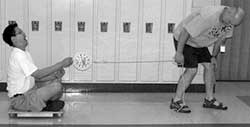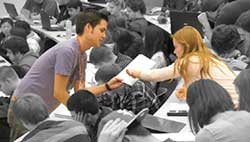PER-based Teacher Preparation at Arizona State
Kelli Gamez Warble, Teacher in Residence, Department of Physics, Arizona State University
During the summer of 1995, I found myself in room PSH 357 at Arizona State University (ASU) alongside 25 of some of the finest high school physics teachers from the United States. Having just finished my first year as a certified teacher, I was the least experienced instructor in the group. I was feeling simultaneously awestruck and inadequate, and frankly, was suspicious that I was only invited because supporting me was cheap since I lived locally and therefore did not need precious grant money for airfare or housing.
I was participating in the Leadership Modeling Workshop in High School Physics, an NSF-funded program for high school physics teachers with David Hestenes as the Principal Investigator. Yes, that David Hestenes—co-author of the Force Concept Inventory, father of Modeling Instruction, winner of the Oersted Medal, and incidentally a top mind in the field of geometric algebra. (The same Hestenes who told me years later, “The best thing I ever did for teaching was get out of the classroom.”)
The FCI had only recently been published and was being used by a fairly small subset of high school and college physics teachers—indeed, university physics instructors were still arguing passionately about its efficacy. None of the teachers in room PSH 357 had ever heard the phrase “Physics Education Research.” We were oblivious to the fact that we were witnessing the insemination of a supportive community of educators that would eventually inspire a grass-roots organization that now reaches thousands of STEM teachers from across the world via the American Modeling Teachers Association.
I spent three summers in room PSH 357 as a workshop participant, modeling and re-modeling how to better teach physics using the classroom practices inspired by Arizona high school teacher Malcolm Wells (co-author of the FCI, and one of the first instructors in the country to document marked student gain in FCI scores). I spent about ten more summers in the same room as a Modeling workshop leader. In the early 1990s, the Modeling Workshop in Mechanics officially became PHY 480 Methods of Teaching Physics at ASU.
Despite my general feeling of inadequacy in 1995, I had been well-prepared. One of my fellow participants, Rex Rice, had actually been my high school physics teacher in Mesa, about 10 miles to the east (and 10 years back in time). Rex was one of the early Physics Training Resource Agents for the AAPT and had used many of the PER-based ideas being discussed in the 1995 workshop when I was his student in the mid-1980s. Equally important, the Methods of Teaching Physics course that I took as a pre-service teacher at Arizona State in the early 1990s was taught by the same excellent high school teacher who was leading the 1995 Modeling Workshop—Larry Dukerich. In fact, the PHY 480 Methods of Teaching Physics course at ASU was (and remains to be) quite unusual for several reasons. PHY 480 was (and still is):
- housed in the physics department rather than the education department.
- taught by an instructor who has typically had at least 10 years of experience actually teaching high school physics using ideas from Modeling Instruction and PER.
- one of the few science methods courses at ASU in which science content is addressed alongside science pedagogy, thereby fostering a strong foundation in what is now referred to as “Pedagogical Content Knowledge.”
- one of the few teacher preparation courses I know of where participants spend a substantial amount of class time in “student mode,” during which they are required to practice “retrograde amnesia” and behave like an introductory physics student, naïve preconceptions and all. (“Teacher mode” questions are banned until after the entire lab or activity has been completed in “student mode.”) I have observed that the more physics experience participants have, the more excruciating it is for them to act like a student, but their difficulty becomes fodder for very rich class discussions about typical student preconceptions.
Although ASU is the home of the FCI, we still don’t house an active research group in physics education. Instead, the ASU physics department has become a haven for practitioners of physics education (i.e. teachers) every summer via our Master of Natural Science (MNS) program. Students in the MNS program are typically practicing high school or community college instructors with a strong desire to become better teachers. They must complete a minimum of three Modeling Workshops, which focus upon the implementation of the latest ideas in education research and are centered around the student creation of rich mental models. Pre-service teachers at ASU also take these workshops to satisfy the “teaching methods” requirement towards their degree.
I haven’t made it very far from room PSH 357. I’m now next door in PSH 355 leading the same course as part of the ASU teacher preparation program. Current students in the class are still constructing the same series of fundamental models in mechanics, still splitting class time between student mode and teacher mode, and still becoming part of a vibrant community of educators discussing how best to prepare our students to think like scientists.
I hear criticism of Modelers, typically implying that we are a group of fanatics who “drank the Kool-Aid” of constructivism. I find this puzzling, since one of the basic tenets of every Modeling Workshop in which I’ve been involved has been to constantly question the effectiveness of our teaching practices, rather than mindlessly adhering to what has been done before. If anything, being part of the Modeling community finally enabled me to feel as if I belonged in physics; prior to that, I always felt out of place in an environment that seemed (almost fanatically) rigid and competitive rather than creative and inclusive.
I just finished teaching another Modeling Workshop in Mechanics this spring in room PSH 355 (next door to the 1995 classroom). There were 29 students in the course, but only 10 were pre-service teachers, and only 2 of these pre-service teachers intend to become physics teachers. The rest were a mix of undergraduate physics majors, graduate students in physics and mathematics, and current high school teachers (including visiting international teachers from Kenya and Indonesia). Despite our diverse backgrounds, just like my first experience in 1995, we became a supportive community of like-minded individuals, all of whom hope to transform STEM education to better reflect the practice of doing science.
Kelli Gamez Warble spent 18 years as a high school physics and mathematics teacher in the Phoenix area, 16 of those years at Title I “high need” schools. She has spent her summers since 1998 leading Modeling Workshops for STEM teachers, and in 2013 led the development team which designed workshops and curriculum for Modeling Instruction in Middle School Science. In fall 2012, she became the Teacher in Residence as part of the Arizona State University PhysTEC program, where she currently teaches and coordinates the Learning Assistant program for the physics department.

Rex Rice, the author’s former HS physics teacher, pulls a colleague while demonstrating an activity in ‘student mode’ (St. Louis, 2006).

Jesse Ruiz, a PHY 480 student and undergraduate Learning Assistant, makes a large lecture introductory physics course more interactive (ASU, spring 2012). After taking a Modeling Mechanics Workshop as a physics major, Jesse decided to pursue a teaching certification.

PHY 480 Methods of Teaching Physics class members at Arizona State University. Spring 2016
Disclaimer – The articles and opinion pieces found in this issue of the APS Forum on Education Newsletter are not peer refereed and represent solely the views of the authors and not necessarily the views of the APS.
